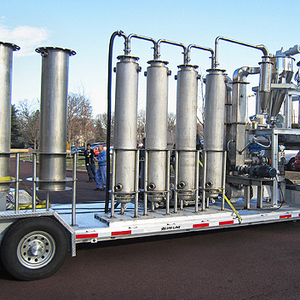USDA researchers simplify pyrolysis for bio-oil production

Photo: USDA, Charles Mullen
April 22, 2014
BY USDA, Ann Perry
Innovations at the USDA are bringing researchers one step closer to developing “green” biofuel production systems farmers can use to meet on-farm energy needs, or to produce renewable fuels for commercial markets. These findings by Agricultural Research Service scientists Charles Mullen and Akwasi Boateng promote the USDA priority of finding new bioenergy sources. ARS is USDA's chief intramural scientific research agency.
Fast pyrolysis is the process of rapidly heating biomass from wood, plants and other carbon-based materials at high temperatures without oxygen. Using pyrolysis to break down tough feedstocks produces three things: biochar, a gas, and bio-oils that are refined to make “green” gasoline [or diesel fuel substitutes].
The bio-oils are high in oxygen, making them acidic and unstable, but the oxygen can be removed by adding catalysts during pyrolysis. Although this adds to production costs and complicates the process, the resulting bio-oil is more suitable for use in existing energy infrastructure systems as a “drop-in” transportation fuel that can be used as a substitute for conventional fuels.
Advertisement
Advertisement
In 2013, the ARS team filed a patent application for a new pyrolysis process called Tail Gas Reactive Pyrolysis, which removes much of the oxygen from bio-oils without the need for added catalysts. The team conducted a pilot-scale study using three types of biofeedstock with different characteristics: oak, switchgrass, and pressed pennycress seeds.
The researchers modified the standard pyrolysis process by gradually replacing nitrogen gas in the processing chamber with the gases produced during pyrolysis. The TGRP process was very effective in lowering oxygen levels and acidity, and no additional catalysts were needed.
Bio-oils produced from oak and switchgrass by the new process had considerably higher energy content than those produced by conventional fast pyrolysis. The energy content of the oak bio-oil was 33.3 percent higher and contained about two-thirds of the energy contained in gasoline. The energy content for switchgrass was 42 percent higher, slightly less than three-fourths of the energy content of gasoline.
The scientists, who work at the ARS Eastern Regional Research Center in Wyndmoor, Pa., published results from their research in 2013 in Energy & Fuels.
Advertisement
Advertisement
Related Stories
The USDA significantly increased its estimate for 2025-’26 soybean oil use in biofuel production in its latest World Agricultural Supply and Demand Estimates report, released July 11. The outlook for soybean production was revised down.
U.S. fuel ethanol capacity fell slightly in April, while biodiesel and renewable diesel capacity held steady, according to data released by the U.S. EIA on June 30. Feedstock consumption was down when compared to the previous month.
The U.S. EPA on July 8 hosted virtual public hearing to gather input on the agency’s recently released proposed rule to set 2026 and 2027 RFS RVOs. Members of the biofuel industry were among those to offer testimony during the event.
The USDA’s Risk Management Agency is implementing multiple changes to the Camelina pilot insurance program for the 2026 and succeeding crop years. The changes will expand coverage options and provide greater flexibility for producers.
The USDA’s National Agricultural Statistics Service on June 30 released its annual Acreage report, estimating that 83.4 million acres of soybeans have been planted in the U.S. this year, down 4% when compared to 2024.
Upcoming Events










